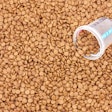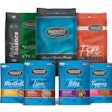
There are many dog and cat foods boasting functional formulas. These pet foods assert the ability to help manage several different health concerns, including:
- Dental disease;
- Hairballs;
- Food allergies;
- Urinary tract disease; and
- Mobility problems
DSHEA of 1994
The rising popularity of pet foods containing functional ingredients can be traced to the Dietary Supplement Health and Education Act (DSHEA) of 1994. This US legislation restricted some of the Food and Drug Administration's (FDA) authority to act against functional ingredients as unapproved food additives. This led to a vast influx of such products for people and influenced similar trends in pet food.
The FDA maintains that DSHEA does not apply to petfoods. So, the same ingredients allowed for people under DSHEA may still be unapproved food additives in petfoods. However, in general, FDA has made such ingredients a low regulatory priority. Pet food companies can make "structure function" claims, such as promotes healthy skin, but if the ingredient is not an approved ingredient (by AAFCO, FDA or NRC) regulators could object.
Scientific evidence
While scientific evidence is growing for the use of some functional ingredients for pets, it is sometimes scarce. There are many questions about the safety and efficacy of functional ingredients in pet food that need to be answered in peer-reviewed scientific literature. However, much of the science is proprietary and unpublished or the studies are in species other than dogs and cats.
Veterinary pet foods
Certain petfoods are formulated to aid in the management of specific medical matters that should be diagnosed and monitored by a veterinarian. Among the commercial veterinary petfoods, top companies in the European, Asian, Latin American and US markets include:
- Colgate-Palmolive Co. (Hill's Pet Nutrition);
- P&G Pet Care (Eukanuba);
- Nestlé Purina PetCare; and
- Mars Petcare (Royal Canin).
A lot of the concepts used in veterinary pet foods have found their way into mass merchant and pet specialty brands. Following are several pet health problems and some of the concepts used to help solve them.
Dental disease
Periodontal disease affects the gums, bones and connective tissue around the teeth. It starts with plaque forming on the teeth. If the plaque isn't removed, minerals in saliva turn it into tartar. Tartar builds up below the gums and bacteria grow, causing inflammation. These bacteria can enter the bloodstream and cause or aggravate lung, kidney, liver and heart problems.
Products for the nutritional management of pet dental disease are usually dry foods that contain an optimum-sized kibble with a texture that scrubs the exposed tooth surface. Antioxidants and glucosamine are often added to promote oral health. Sometimes calcium-binding tartar control ingredients, such as tetrasodium pyrophosphate, are used in these formulations.
Hairballs
An almost constant temperature and artificial lighting lead to regular hair loss in indoor cats. Much of this lost hair can be swallowed during grooming sessions. It may become lodged in the digestive tract and form hairballs. Hairballs can lead to vomiting, constipation or intestinal blockage.
Hairball control formulas contain proprietary fiber combinations, such as cellulose and beet pulp, to help move hair through the feline digestive tract. Purina's hairball control product has "a patent-pending technology utilizing a soy lecithin emulsifier, which prevents dietary fats from combining with undigested hair and forming a hairball."
Food allergies
Food allergies involve an immune mechanism. They generally manifest as skin or digestive diseases marked by pruritus (scratching), vomiting or diarrhea. Food intolerances are adverse reactions to food where an immune mechanism cannot be demonstrated. Food intolerances may result from metabolic or toxic reactions, or from an inability to fully digest food.
Pet foods with a novel source of protein, such as duck, lamb or venison, can provide significant clinical improvement in pets with food allergies. In addition, the antigenicity of dietary proteins can be minimized by enzymatic hydrolysis to produce low molecular weight proteins. There are also hypoallergenic palatants available, says Isabelle Guiller, SPF R&D director, that are "specifically designed with low molecular weight proteins or are free of animal proteins."
With respect to skin disease, both omega-6 and omega-3 fatty acids appear to be anti-inflammatory. According to Iams nutritionists the proper ratio is five to 10 omega-6 fatty acids to one omega-3 fatty acid.
Royal Canin's skin support formula contains aloe vera gel and a "synergistic combination of nicotinamide, pantothenic acid, histidine, choline and inositol" to increase the synthesis of ceramides that are needed for an effective skin barrier.
Urinary tract disease
Feline lower urinary tract disease (FLUTD) is caused by uroliths, urethral plugs or feline idiopathic cystitis. FLUTD is often associated with inflammation of the urinary tract. So petfoods for managing FLUTD often contain higher levels of antioxidants and omega-3 fatty acids to decrease inflammation. Such petfoods also tend to contain controlled levels of magnesium, calcium, phosphorus and oxalate to reduce building blocks of crystals. Some acidify the urine, which helps dissolve struvite crystals.
Mobility problems
Joint disease is common in older pets, especially in overweight dogs of the large or giant breeds. Petfoods for maintaining healthy joints usually contain glucosamine and chondroitin to provide the building blocks of healthy cartilage. Another common ingredient is EPA, an omega-3 fatty acid used to decrease inflammation. L-carnitine is added to help achieve optimum body weight.
Royal Canin joint health products include green-lipped mussel powder (GLMP) for its "unique ability to promote joint health." GLMP is known to contain several anti-inflammatory fatty acids, chondroitin sulfate, glutamine and antioxidant co-factor minerals (zinc, copper and manganese).
Macro, micro and novel
Some of the preceding products claim functionality due to controlled macronutrient levels such as proteins, fats and carbohydrates. Some claim functionality due to controlled micronutrient levels for example, magnesium, antioxidants and zinc. Some claim functionality due to the presence of novel ingredients like chondroitin and green-lipped mussel powder. Whatever the approach, there is a growing consensus that petfoods with functional formulas can help manage several troublesome pet problems.


.jpg?auto=format%2Ccompress&fit=crop&h=167&q=70&w=250)
.jpg?auto=format%2Ccompress&fit=crop&h=167&q=70&w=250)














